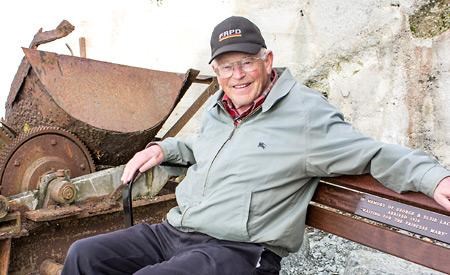A popular way to pay tribute to deceased family members is through a commemorative park bench. But rarely does a bench work so well to memorialize a place’s history as the one Robert Lacey requested for his parents.
Last summer he had the bench placed, as part of the City of Powell River’s memorial bench program, along the newly created seawalk path connecting the south end of the south harbour to Wharf Street.
An inscription on the plaque reads: “For George and Elsie Lacey. Waiting for the Princess Mary.”
“It’s changed a lot since those days,” said Robert, 79, sitting on the bench and looking out at the south harbour. “This whole area used to be just a rocky beach.”
Robert would know—he has spent his whole life in the area.
His parents moved to Powell River in 1924. His father built the family’s home at the corner of Fairmont Street and Westview Avenue, a little yellow house, the only one Robert has ever lived in. He was born in 1935.
Robert spent his childhood and much of his youth on the rocky beach. “It was my front yard,” he said. “Every day I’d be down here and there was always something coming in or going out.”
As a youth Robert worked on the waterfront, first chopping and delivering firewood for Mrs. Hardy’s cookstove at the Marine Inn. (Electric stoves were not used in Powell River until the 1950s after high-voltage transmission lines were strung across Jervis Inlet. Before that, electricity had to be purchased from the Powell River Company, said Robert.) He earned 25 cents each time he filled the wood bin at the hotel, he remembered.
Next to the Lacey memorial bench is a rusty boat winch attached to a large slab of concrete.
“I used to work on this,” he said, looking down at the oxidized metal, the same hue as Powell River’s sunsets. “It’s all changed a lot.” As a teen, Robert worked at McGuffie’s boatyard and machine shop that used to be there. In his free time he would help scrub barnacles off the wooden hulls of resident boats. After an afternoon drying in sea breeze, the hull would be ready for repainting and Robert would be involved.
Before he started his 35-year career with BC Hydro, Robert said he also worked on Shell’s fuel dock, located further down the beach. He remembers the vast fleet of gill-net trawlers that were anchored there and used to plow Malaspina Strait scooping up its coho, sockeye and pinks.
A ship he remembers fondly was the SS Princess Mary, one of Canadian Pacific Railroad’s pocket liners. Built in 1910 it served as Powell River’s only major transportation link to the outside world. Its route was from Vancouver to Nanaimo to Powell River and back to Vancouver. Princess Mary’s dock was originally located in front of the Rodmay Hotel, but was later moved to the Wharf at Westview as the paper mill started expanding its operations.
“I always wanted one of these for my parents,” he said of the bench. “But I didn’t know where to put it.”
He said that after speaking with Paul Nassichuk, parks foreman, and telling him his story it became quite clear that the best place to put the bench was next to the seawalk. Robert remembered that spot, where his bench is now, being one of the best places to wait for Princess Mary’s arrival.
“I’ve spent my whole life down here,” he said.



